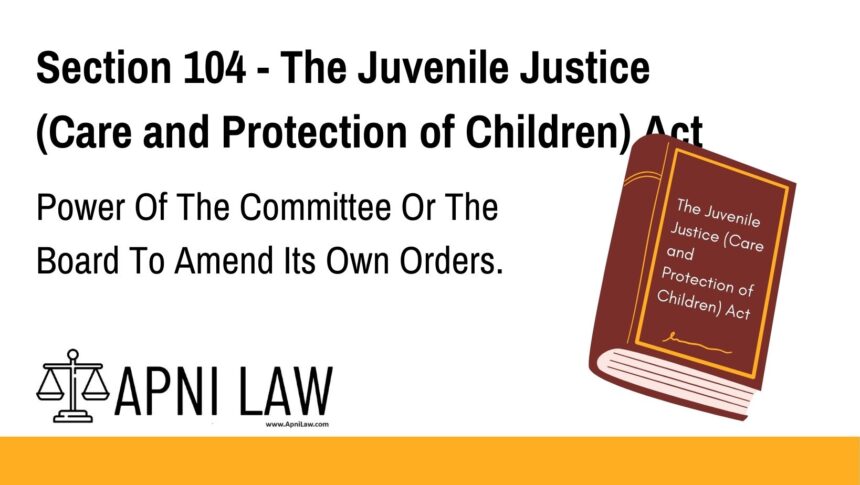Code: Section 104 of the Juvenile Justice (Care and Protection of Children) Act
Power of the Committee or the Board to Amend Its Own Orders:
(1) Without prejudice to the provisions for appeal and revision contained in this Act, the Committee or the Board may, on an application received in this behalf, amend any orders passed by itself, as to the institution to which a child is to be sent or as to the person under whose care or supervision a child is to be placed under this Act:
Provided that during the course of hearing for amending any such orders, there shall be at least two members of the Board, of which one shall be the Principal Magistrate, and at least three members of the Committee. All persons concerned, or their authorized representatives, whose views shall be heard by the Committee or the Board, as the case may be, before the said orders are amended.
(2) Clerical mistakes in orders passed by the Committee or the Board, or errors arising therein from any accidental slip or omission, may, at any time, be corrected by the Committee or the Board, as the case may be, either on its own motion or on an application received in this behalf.
Explanation of Section 104
Section 104 of the Juvenile Justice (Care and Protection of Children) Act outlines the power of the Committee or the Board to amend its own orders. This section provides a mechanism for correcting or altering decisions made concerning the care and placement of children, while ensuring fairness and due process.
Key Provisions:
- Amending Orders: The Committee or Board has the authority to amend orders related to the placement or care of a child if there are reasonable grounds to do so. This can be done on an application received from concerned parties.
- Hearing Requirement: The amendment process requires that at least two members of the Board (one being the Principal Magistrate) and at least three members of the Committee participate in the hearing. The views of all concerned parties or their authorized representatives must be heard before any changes are made to the orders.
- Correction of Clerical Errors: The Committee or Board can correct clerical mistakes or accidental errors in their orders at any time, either on their own initiative or in response to an application.
Illustration
Example 1: Amendment of Placement Order
A Juvenile Justice Board has ordered the placement of a child in a particular institution, but later, the child’s needs have changed. The child’s guardian files an application to have the order amended to place the child in a more suitable facility. The Committee or Board reviews the case, listens to the views of the guardian, the child, and any relevant parties, and amends the order as needed.
Example 2: Correction of Clerical Error
A Board has passed an order placing a child in a particular institution, but a clerical error in the address of the institution is discovered. The Committee or Board can correct this mistake at any time, either on their own motion or upon receiving an application, ensuring that the order reflects the correct details.
Common Questions and Answers on Section 104
1. Can the Committee or Board amend its own orders under Section 104?
Yes, the Committee or Board has the power to amend orders regarding the care or placement of a child. However, this can only be done after hearing the views of the concerned parties and adhering to certain procedural requirements.
2. What is required for the Committee or Board to amend an order?
To amend an order, the hearing must involve at least two members of the Board (one of whom must be the Principal Magistrate) and at least three members of the Committee. All concerned parties or their authorized representatives must be heard during the process.
3. Can clerical errors in the orders be corrected?
Yes, clerical mistakes or accidental omissions in orders can be corrected at any time by the Committee or Board, either on their own initiative or upon receiving an application.
4. Is there a time limit for amending an order?
There is no specific time limit mentioned for amending an order under Section 104. However, the process should follow the procedures and ensure fairness to all parties involved.
5. Can an order be amended if it affects the child’s welfare?
Yes, the Committee or Board can amend orders if it is in the best interest of the child. This amendment process is guided by the principle of prioritizing the child’s welfare and needs.
Conclusion
Section 104 of the Juvenile Justice (Care and Protection of Children) Act provides the Committee or Board with the authority to amend their own orders concerning the care and placement of children, ensuring flexibility and accuracy in their decisions. This process, which includes a requirement for hearings and the correction of clerical errors, guarantees fairness and responsiveness to the needs of children under the Act.
For more information on juvenile justice laws, visit ApniLaw today!








